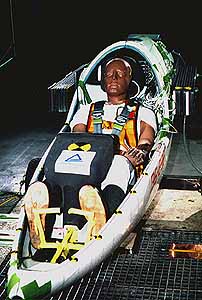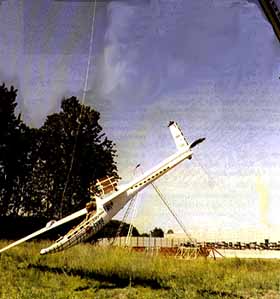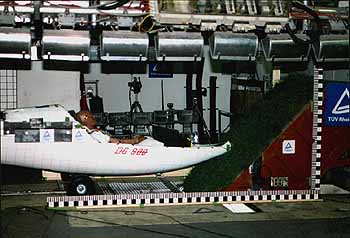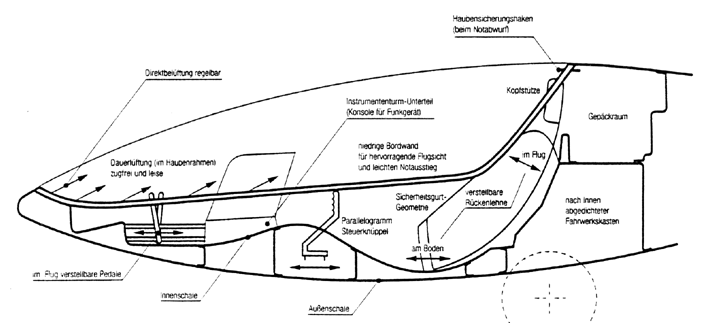The cockpit of a DG glider is clearly different from the cockpits of other manufacturers because the canopy is much larger. This large canopy was an important factor in my choice to buy a DG-800. In spring I see the trouble and expense my colleagues go to with fur lined boots and electric insoles which drain their batteries in order to keep their feet warm. It is a pleasure to fly at 4000 m in thin, comfortable sport shoes with the sun shining on your feet and legs! In the summer, strong ventilation is available. In the community of internet users the majority opinion favors the large canopy concept. Very often we hear the suggestion:
“Don’t change your canopy. It is great!”.
On the other hand, it would seem obvious that in the case of an accident, such a design would not offer the same degree of safety as one with a higher canopy rim and a more enclosed front fuselage. But is this really true? It is very doubtful if this view would stand up to careful examination.
 The “Technical Supervision Company” of Rhineland, Germany looked at and tested extensively the crash-worthiness of sailplane cockpits several years ago. He differentiates the following typical accidents:
The “Technical Supervision Company” of Rhineland, Germany looked at and tested extensively the crash-worthiness of sailplane cockpits several years ago. He differentiates the following typical accidents:
1. Low speed, nose high, “pancake” landings.
2. Less steep hard landings at an angle of about 10 degrees at normal speeds.
3. Typical out-landing accident, nose 30 degrees down followed by a ground loop; normal speed.
4. Crash at 45 degrees at high speeds, for example from a spin or ramming an obstruction during roll-out.
5. Not considered were accidents which necessitated the use of a parachute.
By the way, you can click on the “Photos” section and see this in detail.
The results in the 4th case indicated that no modern sailplane cockpit can protect the pilot. Since there is no crush zone in a glider as there is in an auto, a crash at higher velocities – mostly over 60 knots – is not survivable. In actual crash tests at “only” 30 knots and only directly on the nose, high loadings were measured with dire results for the pilot.
 These results are valid for all cockpits available at that time. The same results were obtained by Prof. Roeger at the Aachen University of Applied Sciences. He is the same person who invented the Roeger Hook that is supposed to result in safe canopy ejection. Here the cockpit of a DG-800 was also tested and at the same time a newly constructed model from one of our competitors. The results show that the stability of the DG800 cockpit is greater than that of our competitors.
These results are valid for all cockpits available at that time. The same results were obtained by Prof. Roeger at the Aachen University of Applied Sciences. He is the same person who invented the Roeger Hook that is supposed to result in safe canopy ejection. Here the cockpit of a DG-800 was also tested and at the same time a newly constructed model from one of our competitors. The results show that the stability of the DG800 cockpit is greater than that of our competitors.
Conclusion:
Pilots are reasonable protected by all modern cockpits in the first case of the of the hard “pancake” landing. The landing impact is taken mostly by the main gear support which is capable of absorbing a large amount of energy even when it is badly damaged in the process. The double walled fuselage around the cockpit gives further protection. Pilots are also assured by these results that the landing gear should be lowered for all landings. Plowed fields, water, and even a field which is too short. In this last case, it’s best to do an intentional ground loop.
The effectiveness of a more or less specially built safety cockpit will show its effectiveness in the second and third cases: The 10 degree and 30 degree nose low landings at normal speed as well as the fourth case if the speed is not all too high.
The more enclosed cockpit of the same construction can certainly absorb a higher impact energy than one with a large canopy. It is evident that this advantage is effective only in special situations. But then every accident is a special situation.
 Unfortunately, the presumed advantage comes with the price of a whole row of disadvantages. Cold feet are unavoidable when they are deep under the instrument cluster possibly near the ventilation. In addition, our cockpit is comparatively large and thereby comfortable. When a pilot has flown 6 hours, is still comfortable, and not exhausted, perhaps he will not make the critical mistake leading to an accident.
Unfortunately, the presumed advantage comes with the price of a whole row of disadvantages. Cold feet are unavoidable when they are deep under the instrument cluster possibly near the ventilation. In addition, our cockpit is comparatively large and thereby comfortable. When a pilot has flown 6 hours, is still comfortable, and not exhausted, perhaps he will not make the critical mistake leading to an accident.
Finally, the entry to a cockpit with large canopy is much easier than when one has to thread his legs in under an instrument panel. The hinged instrument panel solves the problem of the enclosed front fuselage section but carries the added danger of head injury in an accident.
It is evident then that the intended advantage of greater protection brings with it the price of a whole series of disadvantages. Naturally every new DG glider has all the safety components that are possible and meaningful. The cockpit has a continuously bonded inner shell as an additional stiffener and the whole fuselage of the DG-808B consists of Kevlar and carbon fiber (Hybrid-Construction). The cockpit rim is especially strengthened because it must withstand the greatest force.
The fifth type of accident involving exiting the aircraft with a parachute was not investigated by the Rhineland Company. But in this case the large canopy has a greater, perhaps life-saving advantage.
When I sat in a glider of a competitor I felt as protected as a baby in a womb with a canopy rim up to my armpits. But how should I get out when the glider is spinning uncontrollably toward the ground? Even normal entry and exit on the ground gave me problems. This type of accident occurs mostly as a result of mid-air collisions. It is self-evident that the danger of not being able to get out is minimized by the large canopy design with its excellent visibility.

– K.-F. Weber -.
